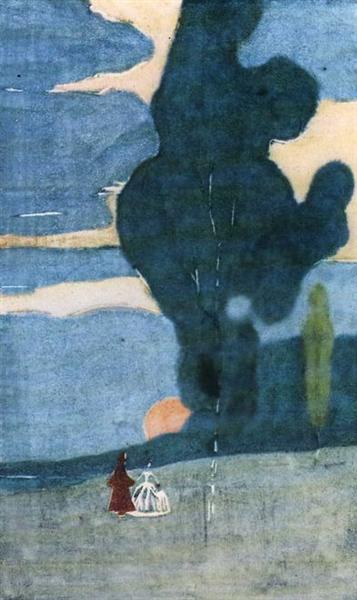Description
"Exit from the moon" (1903) by Wassily Kandinsky is a work that is part of the artist's first years, at which time he began to explore the possibilities of color and the way to express emotions and spirituality. He painting It presents a night landscape where the moon stands on a dramatic background of dark tones. The composition is characterized by a tension between the natural environment and the use of color, elements that would become distinctive stamps of Kandinsky's work.
When observing the painting, the first thing that stands out is the luminosity of the moon, a white circle that becomes the central focus of the work. Lunar light radiates in a deep blue background that evokes an atmosphere of mystery and tranquility. The choice of blue, along with the dark tones that surround it, reinforces the idea of a serene night, but loaded with symbolism. This game of lights and shadows not only represents the duality between light and darkness, but can also be interpreted as a metaphor for the internal conflict in the search for spirituality and meaning of existence.
The composition is organized in such a way that the moon seems to ascend, suggesting a movement towards the divine. Around it, you can find silhouettes of abstract forms that, although they are registered within the landscape context, lack a clear and specific representation. These forms evoke at the same time natural elements and a feeling of spirituality, characteristics that will become more prominent in their subsequent work. The choice of complementary colors, such as yellow and oranges that contrast with predominant blue, serves to intensify the emotion of the moment represented, a search for the sublime in nature.
It is interesting to note that at this stage of his career, Kandinsky had not yet adopted the abstract style that would characterize him in his best known works. "Exit from the Moon" is, on the other hand, a transition work that allows to glimpse its evolution towards abstraction. This work is aligned with its growing interest in color and emotion theory, which would later be formalized in texts such as "spiritual in art."
Kandinsky, influenced by his study of music and his synesthesia, sought that the viewer experience the work of art in a similar way to how music is experienced, through an emotional connection rather than rational. In "exit of the moon", this connection becomes evident in how the viewer can feel both the calm of the night and a sense of yearning for transcendence.
In the context of the art of the twentieth century, this painting is a testimony of Kandinsky's first explorations towards a more abstract and emotional language that would subsequently consolidate in his career. Contemporary works of artists of the time also reflect this concern to explore the relationship between color and emotion, as can be seen in the works of Paul Klee or Henri Matisse. "Exit from the moon" represents a fascinating facet of these explorations, serving as a bridge between the figurative representation and the freedom of abstract language that characterizes modern art.
In summary, "Exit of the Moon" is a fundamental work that not only stands out for its aesthetic beauty, but also invites a deeper reflection on the nature of art and the spiritual search for the human being. Kandinsky's ability to challenge the viewer through color and shape is a sample of the transforming power of art, a legacy that lasts in his work and continues to inspire generations of artists and fans equally.
KUADROS ©, a famous paint on your wall.
Reproductions of paintings handmade oil, with the quality of professional artists and the distinctive seal of KUADROS ©.
Art reproduction service with satisfaction guarantee. If you are not completely satisfied with the replica of your painting, we refund your money 100%.

